

| Invertebrate news 2020 |
| Insect and Arachnid related news from around Nottinghamshire |
| Want your interesting or notable Nottinghamshire sightings listed? email tpendleton@eakringbirds.com |
|
The ant Stenamma debile new to Nottinghamshire On the face of it, this is is quite a surprising addition to the county fauna, as the current UK range for Stenamma debile on the NBN Atlas, shows that most records are from East Anglia and coastal areas of the UK. Stenamma debile (Westwood, 1840) was discovered new to Nottinghamshire in October, when a worker was found at the western end of Sherwood Heath, near the entrance to Cockglode Wood. This record very much represents a relatively isolated inland record for Stenamma debile, but is another example of how distribution maps (for mst species) should be used as a guide, rather than fact. Stenamma ants are fairly distinctive, with very small eyes (much smaller than all Myrmica spp) noticeably slower movements and small size. |
||
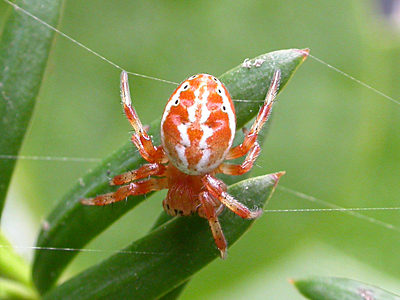 |
New county firsts keep coming The exciting year continues with two new Arachnid additions to the county species list in recent weeks. Both are orb-weavers (Araneidae) and recorded well north of their expected UK range. Agalenatea redii was added to the Nottinghamshire list by Tim Sexton in September, when found to be common in areas of recently created heathland on the site of the former Rufford Colliery near Rainworth. The heathland there contains a good amount of Gorse scrub in parts and Agalenatea redii webs were been found to be common in at least two areas of the site. The latest addition to the list is attractively coloured Araniella displicata, found in a small orb-web on a mature Yew Taxus baccata at St Mary's Church, Edwinstowe in early October. The finding, (especially from a Nottinghamshire Churchyard) will likely raise a few eyebrows - not only for turning up well north of any other UK records, but because UK records are relatively few and according to the Spider Recording Scheme, it is rarely found. |
|
|
Some recent Colletes hederae
records
October sees the peak of the Ivy flowering season, a plant which provides an extremely important nectar source for a huge range of insects prior to over-wintering. One species to rely on it, is the Ivy Bee Colletes hederae (Schmidt & Westrich, 1993) an attractive and easily identified species, which is currently colonising the county and moving north in the process. This distinctive solitary bee was first recorded in Dorset back in 2001, coming only eight years after being discovered 'new to science' in southern Europe in 1993. Colletes hederae was confirmed as having reached Nottinghamshire in 2017 when recorded at Holme Pierrepont by Adrian Dutton, after he had been alerted to the bee's presence by the NWT's reserves manager of the time. It was believed to have been present there since 2016, but in all probablility, it had arrived a year or two earlier than that, most likely in 2014 or 2015. |
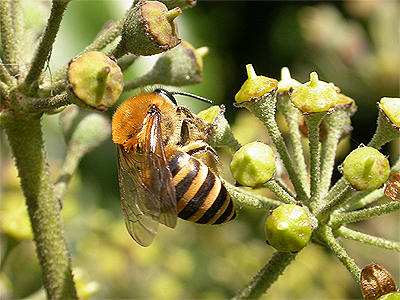 |
|
| ..... | ||
| Confirmed sites for C. hederae to date (October 2020) now include the Nottinghamshire Wildlife Trust's Skylarks Reserve at Holme Pierrepont (per Adrian Dutton), Netherfield Lagoons in 2017 (Rob Woodward), Beeston Rylands in 2018 (Tim Sexton), Southwell in 2018 (Rob Johnson), Gedling (Adrian Dutton) and Church Warsop (T. Pendleton) in 2020. It is clearly an under-recorded species, but a distinctive one to identify. | ||
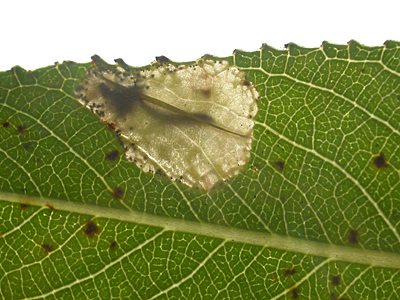 |
The leaf miner Phyllonorycter
pastorella recorded new to Nottinghamshire at Colwick CP Found unexpectedly while walking past a large Willow at Colwick CP on September 21st, a distinctive Phyllonorycter blotch mine caught my eye, as these type of mines (Hymenopterous or Coleopterous mines aside) are rare on long, smooth leaved Willows and especially in Nottinghamshire. Once back home, it was clear that it was a somewhat small mine of Phyllonorycter pastorella (Zeller, 1846) and measured approximately 11mm x 8mm. I sent photographs to Martin Gray and he in turn, forwarded them to Rob Edmunds. Both agreed that the mine was indeed that of P. pastorella. Phyllonorycter pastorella was recorded new to the UK from the gardens of Buckingham Palace in 2014 (Freed 2014) and has since spread to other counties and is clearly another species on the move north. |
|
| ... | ||
| It reached Suffolk in 2019 and Norfolk in 2018, but there are currently (September 2020) no records for the neighbouring Derbyshire, Leicestershire and Lincolnshire, although it must surely be in Leicestershire and Lincolnshire. The larva produces distinctive, large mines on a number of long-leaved Willow species and the adults emerge before over-wintering. | ||
|
Willow Emerald
Damselfly and Scarce Chaser recorded new to Nottinghamshire in 2020 The county Odonata list continues to grow, with the addition of two new species to Nottinghamshire this year. Both Scarce Chaser and Willow Emerald Damselfly have made appearances, pushing the county list to 29 species. Recorded in Nottinghamshire for the first time in 2020 (Bradbury, C.). A colony of Scarce Chaser Libellula fulva Muller, 1784 has been known from along the River Soar near Kegworth for a number of years. The site lies on the Nottinghamshire/Leicestershire border, but the colony was only known from the Leicestershire side. But in June 2020, it was found that some examples did indeed fly into Nottinghamshire. The first UK record of Willow Emerald Damselfly Chalcolestes viridis (Vander Linden, 1825) came from Suffolk in 2007, since when it has continued to expand it's range further inland. It was recently recorded new to Nottinghamshire in September, with two records from different parts of the county. Two were found along a stretch of the Chesterfield Canal at Gringley in September 2020 (Phil and Steph Lee), just two days after three were reported from Sellers Wood Nature Reserve on September 13th 2020 (DS, per British Dragonfly Society's website). |
||
| Recent records of
the Harvestman Leiobunum sp. A from Worksop There have been two visits to Worksop recently, to continue monitoring the population of the extremely long-legged (and still scientifically un-named) Harvestman Leiobunum sp. A - a species we found new to the UK at Worksop back in October 2009. |
||
| ... | ||
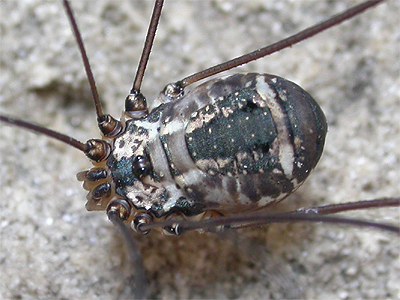 |
The first survey of 2020, took place on August 22nd. Only 58 Leiobunum sp. A. were found in three relatively small aggregation, the largest being of 28 rather restless individuals. This restlessness is thought to have been due to the very windy conditions over the previous few days, as this aggregation was rather exposed, but was in one of the usual (well used) locations on the south side of Worksop Priory. A second visit took place on September 13th, after a large aggregation of was found on Bridge Street in Worksop, by Ludwik Michalek the day before. This was the first report of any Leiobunum sp. A. away from Worksop Priory since the original finding back in October 2009 and confirmed our thoughts for a number of years, that it occurred at other sites locally. The aggregation was under an archway at the side of a Café, close to the Bridge Street/Newcastle Street junction. From what I could see, the aggregation here totalled 48 individuals. A survey of Worksop Priory's walls produced a count of 52 Leiobunum sp. A, so it does seem as though there has been a decline in numbers on the Priory over the past few years, probably due to a localised expansion of range. |
|
|
Coleoptera new to Sherwood Forest in
2020 A number of new species have been added to the Sherwood Forest NNR species list over the course of 2020. All came during casual walks around the forest, rather than directly targeted surveys, but sorting bags full of various mediums proved to be especially fruitful. Much of the recording in the Sherwood Forest Country Park this year, revolved around some old straw bales and old wood chippings in an area we always referred to as the 'dump', of which samples were collected over the course of several weeks and taken home for sorting through by hand during the dark evenings of early Spring. Although hand sorting carrier bags of material can become tiresome after a while, its a worthwhile practice and if you have a broader interest which covers several invertebrate Orders, it becomes even more well worth the effort, allowing a range of (admittedly mainly small) species to be found which you're unlikely to come across by other methods. Plus, with a glass of your favourite tipple, it makes a pleasant way to pass an evening. |
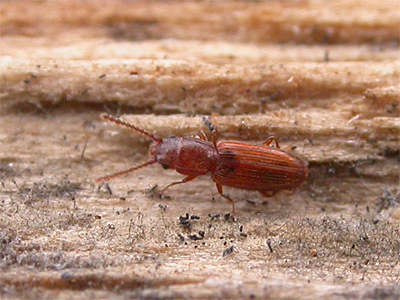 |
|||||||||||||||||||||||||||||||||||||||||||||||||||||||||||||||||||||||||
|
||||||||||||||||||||||||||||||||||||||||||||||||||||||||||||||||||||||||||
|
Convolvulus Hawk-moth at Ravenshead Dave and Veronica McGeever report their second Convolvulus Hawk-moth within a year. This one was found near the light trap runs from their Ravenshead home on August 20th and follows the individual they recorded last year on September 13th 2019. But while it currently remains generally quiet for migrant activity (despite good numbers of Silvery Y) odd species keep turning up. Phil Lee reports a Webb's Wainscot Globia sparganii (Esper, 1789) to MV light on August 22nd and what looks to be Nottinghamshire's third record. Phil has also recorded Haworth's Minor Celaena haworthii (Curtis, 1829) over recent weeks. |
||
|
The Passenger recorded at Misterton
If anyone were having any doubts about Jersey Tiger occurring in land-locked Nottinghamshire, think again. Just a day later and Phil and Steph Lee recorded the county's first record of The Passenger from their Misterton garden on August 6th. The Passenger Dysgonia algira (Linnaeus, 1767) is a moth of southern Europe and Africa and an extremely rare migrant to the UK, where it has been recorded on relatively few occasions. For an inland county such as Nottinghamshire, it must rank as the Holy Grail of Moths and one which no one would ever have forecasted. But with some good southerly winds, anything is possible and not everything drops down on the coast. |
||
|
Tiger Tiger! - Another new moth for
VC56 It's been a funny old year so far. Not sure what others have found, but locally there seems to have been far fewer moths and some quiet evenings around the trap ... even in July. But while things have been a bit slow, there has certainly been some quality for those putting in the effort and such effort by Phil Cadman (from the comfort of his garden) was rewarded by Nottinghamshire's first record of Jersey Tiger Euplagia quadripunctaria (Poda, 1761), which arrived at Phil's trap around midnight on August 5th. Once restricted to the Channel Islands and in places along the UK's south coast, Jersey Tiger has spread in recent years to other southern counties, London and now appears to be moving northwards. Phil's Worksop record came during a favourable spell of southerly winds which saw migrant activity from a number of sites.
|
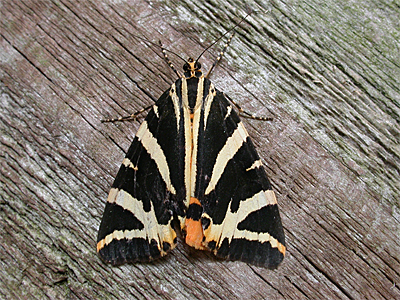 |
|
|
Two new leaf mining moths new to
Nottinghamshire For some reason, July seems early to be looking for leaf mines. But even casually doing so has provided what look to be two new moths for the county species list. Both species can be viewed via the photo galleries. Parornix fagivora (Frey, 1861) Leaf mines found on young Beech trees growing in dense shade at Thieves Wood in July 2020, appear to be the first Nottinghamshire record. The moth has a southerly UK distribution, with Nottinghamshire pretty much at it's northerly limit. Phyllonorycter hostis ([Denis & Schiffermüller], 1775) Recorded new to Nottinghamshire, when a single leaf mine was found at Netherfield Lagoons in July 2020. Initially thought to be the leaf mine of Phyllonorycter blancardella, it was only when the adult emerged that the original ID was questioned. Identification was confirmed by examination of the pupal cremaster and the presence of a simple, thin cocoon within the mine and the frass piled to one side. |
||
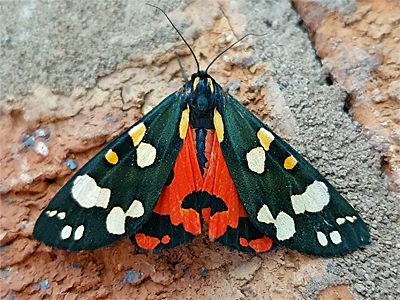 |
Three recent records of Scarlet Tiger Sean Tobin, Andy Adcock and Peter Smith, have all recently sent in reports of Scarlet Tigers in Nottinghamshire. The first was trapped by Sean at Bestwood Village on June 23rd, followed a few days later by Andy recording one to light at Carlton, Nottingham on June 26th. Then Peter Smith found another at Netherfield Lasgoons on July 2nd. These look to be the third, fourth and fifth county records, following previous records from Southwell in 2015 (Yates, D.) and Beeston in 2018 (per Sexton, T.). The Bestwood Village record occurred on the same night as one in Grantham (per Facebook) which was actually a first for South Lincolnshire. What is interesting is that these and the Southwell record, occurred during, or immediately following spells of very warm and humid weather. Scarlet Tiger is clearly prone to wandering during such weather, but it must also be beginning to slowly spread further north. More records will likely follow over the next few years. Grateful thanks go to Andy, for allowing the use of his photograph right. |
|
|
Least Carpet in Market Warsop Steven Chick recorded what seems to be Nottinghamshire's fourth record of Least Carpet, from his home in Market Warsop on June 25th. Only recently recorded new to Nottinghamshire in July 2017, when attracted to MV light at Phil Lee's Misterton garden, Once restricted to south-eastern counties of the UK, Least Carpet has spread inland and northwards in recent years, so it is perhaps surprising that it took so long to be recorded here. Other records have come from Broadholme in July 2018 and Misterton again in 2019. |
|
Glow Worms in south
Nottinghamshire The continued survey work of the Nottinghamshire Glow Worm Survey continues and it is especially pleasing to be able to report a new site for Glow Worms, at Ruddington in the south of the county. The last reported sighting of Glow Worms, nearest to this site, was from Gotham back in 1969. The site is located along a little-used railway line and is private. The colony was found by Izzy Smith on June 2nd and it took a while before another visit could be arranged by Martin Dale and Phil Parry on June 26th, who were able to confirm the record and reported nine females from the area. |
|
Some evidence of the
Wool Carder Bee increasing in Nottinghamshire
The Wool Carder Bee Anthidium manicatum (Linnaeus, 1758) appears to be on the increase in the county, following recent records from Misterton and Carlton. The Misterton record came from Phil Lee's garden and obviously marks the most northerly of the few county records to date. But encouraging sings concerning sightings of both male and female, have come from Adrian Dutton's suburban Carlton garden in June. Having both sexes at the same site, obviously means that breeding is taking place in Nottinghamshire now. Certainly a species to continue to look out for. |
|
An unusual ID request and record Getting many requests for insect identification comes with the territory when you have a website. But among a range of blurred, often shaky and out of focus photographs, which the person requesting the identification purports to show something obviously so deadly, that it had to squashed before asking what it was, are photographs such as the one on the right. What's unusual about Stuart Davenport's superb accompanying photograph, is the fact that its actually in focus, its clear, sharp and wonderfully composed, although being such is not unusual for Stuart I should point out. But it is another squashed identification subject, which was the purpose of Stuart's original request. And it was one I believed I could help with. There's been hundreds of requests over the years, including one sent from Thailand or some other place just over the border into Debyshire. The requester didn't even know if it was a bug, beetle, fly or anything else, but within half an hour we'd somehow named it successfully and they were happy. Stuart wanted to know what the female Redstart he'd photographed at Sherwood Forest CP earlier that day, had collected to feed it's young. Fortunately, with Stuart messaging me the original photograph, I was able to enlarge the image for a closer look, noting that the prey item had relatively long and narrow wings, which were completely black. The bright orange abdomen was also a clue to its identity, which I believed to be a Red-necked Footman Atolmis rubricollis (Linnaeus, 1758). Despite being recorded fairly widely across the county, Red-necked Footman is still quite an uncommon moth in Nottinghamshire ...... even more now the population is minus this one! |
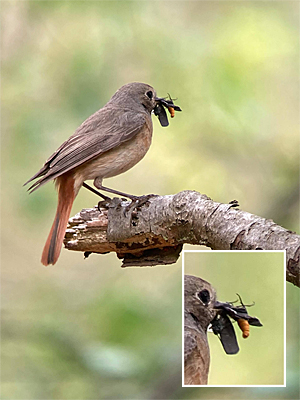 |
|
| ... | ||
| No single site seems to be producing them on an annual basis and there are few reports each year. It was first recorded at Sherwood Forest in June 2013, when Dilys and I trapped it at Clipstone Old Quarter and which was the first Sherwood Forest record since the 1800's. Sheila Wright and John Osborne also recorded it from the Sherwood Forest CP in 2017, so it is by no means regular there. So while Stuart's record shows the demise of one specimen, it does provide us with an important (if rather unusual) county record. | ||
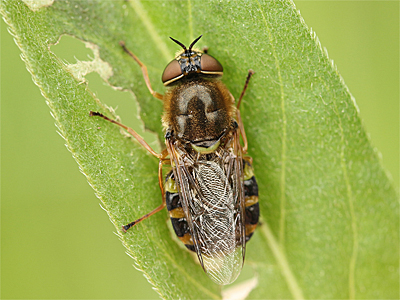 |
Ornate Brigadier
found new to Nottinghamshire Tim Sexton and his three year old daughter Sophie, found one of the famed 'big five' Soldier Flies (Stratiomyidae) at Attenborough Nature Reserve on May 23rd. Ornate Brigadier Odontomyia tigrina (Meigen, 1822) shown left, is a rare species nationally, with most records coming from a few coastal areas around southern England. It is considerably rarer inland and so its discovery at Attenborough NR, surely represents an unexpected addition to the Nottinghamshire fauna. Small Eggar rediscovered in the Newark areaPhotographs showing a nest of Small Eggar larvae, is the first proven evidence that this extremely rare Nottinghamshire moth has survived years of bad hedgerow management, producing the first record for VC56 since 2007. |
|
| ... | ||
|
The Small Eggar Eriogaster lanestris (Linnaeus, 1758) has long been on the verge of becoming extinct in Nottinghamshire and indeed, many people probably thought it already had been recorded for the last time. All of the county's recent records have been from the Sutton-on-Trent, Besthorpe and Collingham areas north of Newark, where larval webs were recorded for the first time in over 60 years in 2002, 2003 and again in 2004. The last confirmed sighting was between Collingham and Besthorpe, by Jim Lennon and Carl Cornish in 2007. Fortunately, the news appears to be even better, with at least three different larval webs apparently known from the same general area. Webs have also been found just over the border in Lincolnshire, so it appears to be having a good year. |
|
First female Glow Worm at Clipstone
Old Quarter The first female Glow Worm of 2020, was found glowing along section M of the old Clipstone Old Quarter survey area on May 20th. May 20th is the third earliest date on which we've recorded Glow Worms at Clipstone Old Quarter, also being the same date on which the first female appeared on back in 2017. The earliest recorded females at this famous Sherwood Forest site, appeared on May 13th 2011 and May 18th 2014. |
|
Three notable records for the
Sherwood Forest NNR Despite so much fine weather over the current Spring, there seems to be few insects about in terms of actual numbers. Even common regulars such as the green Phyllobius Weevils, Ladybirds, Bumblebees, Shieldbugs and most others, are very much in short supply this Spring. I don't know if other entomologists have noticed the same in other parts of the UK, but there's just not the numbers of the most common species still, even approaching the last week of May. But saying that, after wandering through areas C12, C13, C14 and C15 of the Sherwood Forest CP on May 20th, I had one of those ten minute spells of three 'silly' records, which encapsulate the joys of invertebrate recording. After wandering around and finding nothing of note, suddenly in the space of 25 metres I'd found two new Shieldbugs for the Sherwood Forest NNR and a lick beetle not seen there for around a century. |
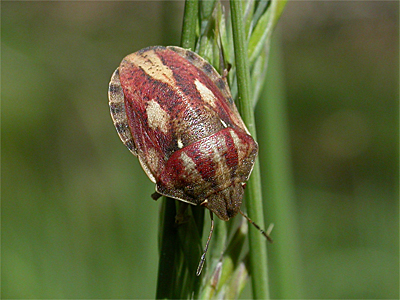 |
|
|
First it was the click beetle Ctenicera pectinicornis, last seen at Sherwood (and Nottinghamshire) about 100 years ago. Overjoyed at the find, I walked on a few yards and then found myself looking at the Tortoise Shieldbug Eurygaster testudinaria (Geoffroy, 1785) shown above. It was another species Dilys and I had never recorded and only appeared in Nottinghamshire in 2019 (Matthews, D.). A short walk further on and I was stunned to be looking at the NNR's first Brassica Bug Eurydema oleracea (Linnaeus, 1758) completing a remarkable trioof records from the Sherwood Forest area. What was just as remarkable, was that I was contacted by Mike Hill from Centre Parcs, who'd just recorded Brassica Bug there. So despite there being 'little about' species are moving north a rate of knots .... especially in Notts. These are exciting times for the county's entomologists. |
||
|
|
The Harvestman
Platybunus pinetorum found new to Nottinghamshire With a well known interest in Harvestmen, there had always been a number of species we'd been on the lookout for over the past 15 years. So it makes it especially rewarding when one turns up, in the end quite unexpectedly and certainly a surprise. The surprise came in where Nottinghamshire's first record of Platybunus pinetorum (C.L.Koch, 1839) was ultimately found, along the edge of woodland at Gleadthorpe and coming in much the same well vegetated habitat as the related (and far more widespread) Platybunus triangularis. Unknown in the UK until first recorded from a Sheffield garden in 2010. Platybunus pinetorum has since been found at Glasgow and Aberdeen in Scotland, Northern Ireland and in the UK at Yorkshire, Northampton and a number of other towns, with an increase in records shown over the past few years and which is probably due to a greater interest currently being showed in Harvestmen. |
|
|
A rare county record of Glaucous
Shears from Nuthall Paul Baker reports trapping a single Glaucous Shears Papestra biren (Goeze, 1781) from his Nuthall garden on May 14th, only the county's second record of this moorland species in recent years. Paul's record is only the third Nottinghamshire record in the past 30 years, proving that Glaucous Shears is a real county rarity. Presumably wandering from neighbouring Derbyshire (or possibly even further afield) the county's most recent record was trapped by Dave Morton and Andy Ashley at Hills and Holes SSSI, Market Warsop on April 28th 2011, some 21 years after a record in 1990. and another.....Following hot on the heels of Paul Baker's record of May 14th, Martin Gray reports trapping another Glaucous Shears in his Broadholme garden on the Nottinghamshire border with Lincolnshire on May 16th. |
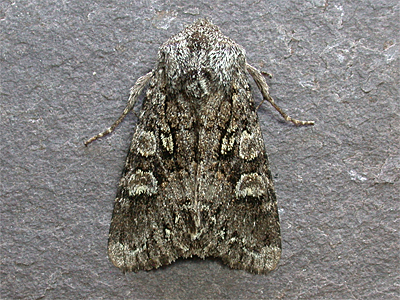 |
|
| ... | ||
|
Unexpected records such as these are a typical example of what makes
moths and other invertebrates such an interesting study. Last year
around the same time, it was another wanderer that was turning up. Light Knot-grass Acronicta menyanthidis (Esper, 1798) is typically a moth of damp heathland and moorland in the northern half of the UK, but there were records at Netherfield Lagoons on May 24th 2019 (the first Nottinghamshire record since the publication of Carr's book in 1916) and which occurred as part of an unusual influx to sites in South Yorks, Lincolnshire and Leicestershire in late May 2019. Remarkably, a second individual was trapped a few weeks later, at Barnby, Newark on June 30th. |
||
| Agelastica alni
continues to colonise new areas of the county Once regarded as being extinct in the UK and even considered as being a migratory species, the Alder Leaf Beetle Agelastica alni (Linnaeus, 1758) underwent a sudden expansion of range, with a string of records stretching from Merseyside, across the country to the Humber. Scattered records from many southern UK counties around the same time, tended to agree with the beetle having migratory tendencies. But after being found in Nottinghamshire for the first time by Pauline Bradford at Dyscarr Wood in 2014, subsequent records from a large number of other sites, suggested that this metallic blue leaf beetle had colonised the county from populations recently established in the north-west UK, rather than from the near continent. By the end of 2015, it had been recorded from just five Nottinghamshire sites and the contrast with the very latest county map provided on the right, shows how quickly Agelastica alni has spread to new sites south-east of where it was originally found. No doubt helped by the large-scale planting of Alder (Alnus sp) on many of Nottinghamshire's former Collieries, large numbers quickly built and the beetle is now found in very large numbers at those sites where it has already been present for a few years. But a series of records in April and May, are already showing that its spread is quite relentless and that its choice of host plant is broadening. We've known for a number of years, that it will move to other trees such as Goat Sallow Salix caprea and Silver Birch Betula pendula, having observed this at Manton Pit Wood, Worksop in September 2015, especially once Alder leaves are in short supply. A number of records have now started coming from the Sherwood Forest area, being found new to the Sherwood Forest NNR on May 5th, followed within a couple of days with records from Budby South Forest and several parts of the Sherwood Forest Country Park, where Birch is the preferred choice of hostplant. But the spread has also continued south and beetles were found to have reached Gedling Pit Top on May 3rd (Julie Lockett) and Attenborough NR on May 5th (Tim Sexton). |
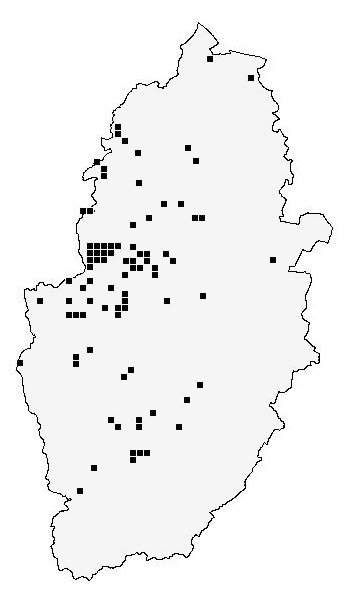 |
|
|
|
More lockdown
firsts and other recent county records Spring 2020 is proving to be one of the most exciting periods for Nottinghamshire's invertebrate fauna in recent years, providing a selection of new species and some long awaited secoind county records. A selection of the most interesting species/records so far (May 12th) are listed below, many being found by less often used methods of collecting and surveying, which has certainly been an eye opener personally. Nephus quadrimaculatus Herbst, 1783 (Coleoptera - Coccinellidae) A record from an Attenborough garden, where it was beaten from an Ivy covered tree by Tim Sexton in May, looks to be the first Nottinghamshire record. Most UK records are from south-east counties, with records also coming from parts of the West Midlands. |
|
| ... | ||
|
Kissophagus hederae Schmitt, 1843 (Coleoptera - Cuculionidae) Found new to Nottinghamshire when beating Ivy growing on trees opposite the old entrance to the Sherwood Forest CP in May 2020. Kissophagus hederae has a very patchy UK distribution, with most records coming from south-east counties, parts of south Wales and West Norfolk and Suffolk. Possibly increasing its UK range. Dorytomus tortrix Linnaeus, 1761 (Coleoptera - Curculionidae) Uncommon in Nottinghamshire, with records by Derek Lott from Stanford, on the county border with Leicestershire, found on two occasions at Holme Pierrepont by Adrian Dutton and most recently from Thoresby Colliery in early May, when it was beaten from Aspen. Oxystoma pomonae Fabricius, 1798 (Coleoptera - Curculionidae) There are recent records from the NWT's Clarborough and Bentinck Banks Reserves in 2002 and 2007 respectively, but the county's most recent record seems to be from Sherwood Forest (see accompanying photograph above), where singles were beaten from vegetation in May. These are the first Sherwood Forest records since 1899. Erichsonius cinerascens Gravenhorst, 1802 (Coleoptera - Staphylinidae) Several turned up in a wet moss sample from Warsop Main Pit Top in early May No traceable county records since Bob Merritt recorded Nottinghamshire's first at Mattersey Hill Marsh in 2004. Stenus ater Mannerheim, 1830 (Coleoptera - Staphylinidae) Relatively few UK records and many of these are from coastal localities. Singles were taken on two occasions from a moss sample taken from the side of a body of water at Warsop Main Pit Top in late April and early May. Both specimens were keyed out for identification and there are believed to be no revious Nottinghamshire records. Stenus atratulus Erichson, 1839 (Coleoptera - Staphylinidae) A seemingly uncommon/rare Stenus across the UK, with relatively few confirmed records. Historically, there seems to be just one previous Nottinghamshire record. This came from Sherwood Forest in 1905 (Kidson-Taylor, J.), well over a century before one was found in old straw bales at Sherwood Forest CP in April. Stenus pusillus Stephens, 1833 (Coleoptera - Staphylinidae) This small Stenus seems to be uncommon in Nottinghamshire. Three found in a wet moss sample taken from the side of a pond at Warsop Main Pit Top in early May, seem to be the first county records for a number of years. The county's other records, are from the very south of the county. Pselaphochernes scorpioides Hermann, 1804 (Pseudoscorpiones - Pselaphochernes) Adrian Dutton found the first Nottinghamshire record of this long-awaited species, while sieving/hand sorting bark mulch at Stoke Bardolph Wood in early May. |
||
| The finds continue
as Nottinghamshire remains in lockdown Even with the current restrictions on movement, getting out for an hour's excercise can still provide much to entertain the bored entomologist. Short trips to collect leaf litter to sort through later at home, have continued to provide the county with a number of notable records. A few are listed here, proving that there is much useful recording work which can be undertaken during the current Covid-19 crisis. Chthonius (Ephippiochthonius) tetrachelatus Preyssler, 1790 (Pseudoscorpiones - Chthoniidae) Had only been recorded once in the county since historical records from Bulwell Hall Wood, Grives Wood near Kirkby-in-Asfield and Mansfield Woodhouse in 1903, when was recorded on 17/04/03 from Walkeringham NR in north Nottinghamshire (Williams, H.). But I have two recent records including four (including three adults) from a leaf litter sample taken from a disused railway line at Market Warsop on 20/04/20, quickly followed by another in a woodchip/leaf litter sample from Cuckney on 27/04/20. Cephennium gallicum Ganglbauer, 1899 (Coleoptera - Staphylinidae) A single taken from a leaf litter sample, taken from a disused railway line at Market Warsop on 20/04/20. Rhizophagus depressus Fabricius, 1792 (Coleoptera - Monotomidae) A second record for the Sherwood Forest NNR, following one in 2008. Plinthisus brevipennis Latreille, 1807 (Hemiptera - Lygaeidae) Recorded from a Heather litter sample, taken from the edge of the Gleadthorpe Open in Sherwood Forest CP, is new for the Sherwood Forest NNR and comes just a few weeks from a record at Market Warsop Cemetery. |
| Clitostethus
arcuatus found new to Nottinghamshire? Adrian Dutton (the Coleoptera Recorder for Nottinghamshire) reports finding the tiny Coccinellid Clitostethus arcuatus (Rossi, 1794) at Stoke Bardolph on April 22nd. (See Adrian's photograph right) Typically found on Ivy growing in both deciduous and coniferous woodland (although not confined to woodland), Adrian was surprised when one turned up in his sweep net, along a field edge at Stoke Farm. Although the NBN Atlas lists what should be presumed to be an historical record from Harby in north-east Nottinghamshire (NBGRC), the record is rather vague, apparently being a preserved specimen, with no given collector/recorder or determiner and a grid reference of SK8770. The NBN does list the record as being 'unconfirmed' and if it is indeed historical, J.W. Carr makes no mention of it in his 1916 publication. It is most likely that Adrian's Stoke Bardolph record, is indeed the first confirmed Nottinghamshire record. |
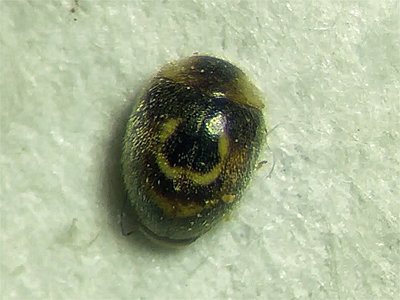 |
|
| Clitostethus arcuatus has a very patchy distribution in the UK, with a largely south-easterly bias, but with records extending north as far as Yorkshire. There have been recent records from neighbouring Leicestershire in April 2020 (per NatureSpot) and from South Lincolnshire in March and October 2010 and March 2016 (per NBN Atlas). Because of it's small size, there must surely be a degree of under-recording of this species, so another to look out for in Nottinghamshire over the coming years. | ||
|
|
Bloody-nosed Beetle
in Nottinghamshire Mike and Joy Hill's walk around an undeveloped section of an industrial state adjacent to the M1 at Strelley, proved rewarding, producing Nottinghamshire's first record of Bloody-nosed Beetle in over 100 years. The record was quickly confirmed by county recorder Adrian Dutton. A large nocturnal and flightless leaf beetle, Timarcha tenebricosa (Fabricius 1775) had not been seen anywhere in the county since the turn of the last century. With a UK distribution covering a large area of south-west England. It becomes increasingly more uncommon the further north-east you go, but there are a number of records from neighbouring Leicestershire and West Norfolk, but distribution is generally very patchy away from south-western coastal areas. In Nottinghamshire, the only traceable records are given in Carr's 1916 book, where he lists records from South Leverton, stating it to be 'common some years', in profusion at Cottam in September, but unfortunately lists no date for both accounts. |
|
| ... | ||
| Carr continues with records for Stokeham (Thornley) and North Wheatley (Chamberlin) and both Rampton and Laneham, between April 16th-19th 1899. But since then, there's been no other reports. All the sites Carr lists are in north-east Nottinghamshire, but as Bloody-nosed Beetle is flightless, maybe its worth keeping an eye out for. The downside to this record, would be that the location will certainly be developed at some point in the future. My thanks go to Mike for allowing permission to use his photograph. | ||
| Invertebrate
recording during the Covid-19 lockdown produces some interesting
county records Following the spread of the Coronavirus (Covid-19) throughout the world during the first few months of 2020, the ensuing pandemic saw governments throughout Europe and in many other countries across the globe, issue tight restrictions on public access and movement in order to stop the spread of the virus. The UK was no exception and government restrictions meant that pretty much everywhere was largely off limits, as exercise was strictly limited. The National Trust closed Clumber Park and the RSPB's Sherwood Forest Visitor Centre closed its doors, but the Country Park remained accessible. Many of Nottinghamshire's nature reserves were similarly affected and recorders were advised to adhere to the restrictions. 2020 therefore, will see most moth trapping being undertaken from home, as sites are temporarily off limits, but it has been possible to do some recording and maintain some standard of normality. |
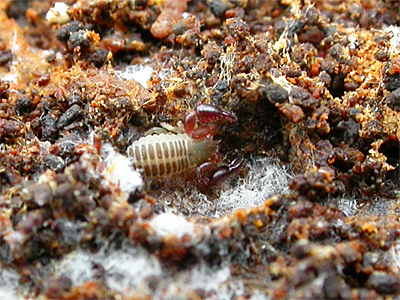 |
|
| ... | ||
|
The limited restrictions did mean that it was possible for me to get my alloted daily exercise, pick up a carrier bag of old straw, leaf litter, wood chippings or old manure, to sort through at home and at my leisure. Its a practice that paid off, with a number of interesting county records. Here's a selection of the most interesting species recorded so to date. Lamprochernes chyzeri Tömövary, 1882 (Pseudoscorpiones - Chernetidae) A Pseudoscorpion with relatively few Nottinghamshire records, but found to be present in good numbers, in a long-standing manure heap at Church Warsop on April 4th and subsequently. Lamprochernes nodosus Schrank, 1803 (Pseudoscorpiones - Chernetidae) New to the Sherwood Forest NNR on March 28th, with just five previous Nottinghamshire records. Cryptolestes duplicatus Waltl, 1839 (Coleoptera - Laemophloeidae) From under bark at Sherwood Forest CP on March 19th. The first record for Nottinghamshire and new for the Sherwood Forest NNR. Coproporus immigrans Schülke, 2007 (Coleoptera - Staphylinidae) Good numbers of this tiny beetle from an old woodchip pile at Sherwood Forest CP on March 28th. It was only recorded for the first time in the UK, as recently as 2004 and has been confirmed as being new to Nottinghamshire and the Sherwood Forest NNR. Euplectus sanguineus Denny, 1825 (Coleoptera - Staphylinidae) From a manure heap at Church Warsop on April 4th and subsequently. Looks to be the first Nottinghamshire record since 1902. Scydmaenus rufus Müller, P.W.J. & Kunze, 1822 (Coleoptera - Staphylinidae) From a manure heap at Church Warsop on April 6th and subsequently. Believed to be the second county record, following a record from Nottingham Trent University's Brackenhurst Campus in 2016 by Wil Heeney. Recently found at Stoke Bardolph by Adrian Dutton on April 11th 2020. Lithocharis nigriceps Kraatz, 1859 (Coleoptera - Staphylinidae) From old straw bales at Sherwood Forest CP on April 11th. Again, this looks to be a second county record, following on from Wil Heeney's 2016 record from Nottingham Trent University's Brackenhurst Campus. Sehirus luctuosus Mulsant & Rey, 1866 (Hemiptera - Cydnidae) An inconspicuous ground-dwelling black Shieldbug associated with Forget-me-not. One found on a path at Clipstone Old Quarter on April 14th, was a perhaps surprising new addition to the Sherwood Forest NNR species list. Plinthisus brevipennis Latreille, 1807 (Hemiptera - Lygaeidae) Recorded in a Pine litter sample taken from Market Warsop Cemetery on March 3rd. An uncommon and rarely recorded Lygaeid bug, known from a just few sites in the north-west of the county. |
||
| Cryptolestes
duplicatus found new to Nottinghamshire at Sherwood Forest An hour or so spent looking under the bark of a number of fallen limbs on the edge of the Sherwood Forest CP produced a small array of species, including notable county records of Silvanus bidentatus (Fabricius, 1792) and an even smaller beetle, later identified as the Laemophloeid Cryptolestes duplicatus (Waltl, 1839). There are few records of Cryptolestes duplicatus listed on the NBN Atlas and this is the first Nottinghamshire record of this 2mm long beetle (confirmed by the county recorder) and currently the most northerly in the UK. Found under the bark of deciduous trees, it was recorded at Sherwood Forest CP on March 19th 2020, on a large fallen limb, where the limb had spliced open on hitting the ground. |
|
Oil Beetles out on Budby South Forest Following on from what has so far been another overall, very mild Winter, I made a trip up to the western end of Budby South Forest on February 27th, in the hope that the first Oil Beetles might already be out. Despite the cool and slightly breezy conditions on the day, the visit paid off with a total of seven adults (including at least one female) found along the usual stretch of path. All were rather inactive and sheltering from the breeze and all were still typically small and obviously freshly emerged. |
||
| ... | ||
|
There are a number of historical
Nottinghamshire records/sites for Meloe proscarabaeus
listed by J.W. Carr in his 1916 book 'The Invertebrate Fauna of
Nottinghamshire'. Unfortunately, no records are dated and Carr's
account reads ' Nottingham; Colwick Wood; Bulwell Forest, common; many
Halictus and Andrena Bees captured on Bulwell Forest and at Gedling in
Spring had larvae of Meloe attached to them (Carr). Kimberley
(Thornley), Clarborough Hill near Retford (Chamberlain)'.
Carr also lists a single (undated) record of Meloe violaceus from Bulwell Forest, Nottingham (Ryles), which adds confusion as to whether this was just a simple misidentification, or that there were indeed two species present at Bulwell Forest (long since a golf course). In 2019, we received an email mentioning that Oil Beetles identified at the time as M. proscarabaeus, were still present at Bulwell Forest Golf Course in the early 1970's, from just off the public footpath crossing the site between Bestwood Road and Hucknall Road at SK547460 (per Scudder, L.). So it might be worth conducting searches to see if this beetle still exists there, for anyone living in the Bulwell/Bestwood and Rise Park area of Nottingham, |
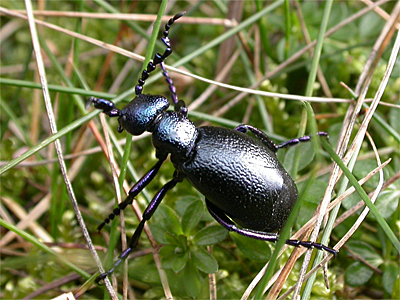 |
|
|
Specimens wanted of an unidentified Assassin Bug known from Cornwall and Nottinghamshire Back in late July 2017, Dilys and I swept an adult Assassin Bug (Coranus sp) from an area of Budby South Forest. The habitat was grazed lowland heath containing a mix of Birch and Pine scrub, areas of Bracken and Heather of various ages and conditions. We took a number of photographs at the time, thinking we were sure of its identity. |
||
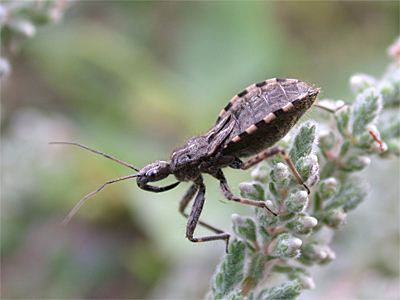 |
Previously, only Coranus subapterus (De Geer, 1773) and Coranus woodroffei (Putshkov, P.V., 1982) had ever been known from the UK, but on return home and after uploading the photographs to our PCs, we noticed that the underside of the specimen was very dark. The angle of our photographs were not the best, but several photographs did show the dark underside quite conclusively and after some research on the internet, we suspected that ours could be Coranus aethiops (Foster 2013). Problem was, we thought that C. aethiops was unknown from the UK, which indeed it was until Stuart Foster re-examined a series of Coranus subapterus specimens collected from Thorne and Hatfield Moors (VC63) in 1979 and 1990. Stuart found that all the specimens were actually Coranus aethiops, making it new to the UK. This boreo-alpine Assassin Bug is a more cold tolerant species and must be regarded as a post-glacial relict species in Britain that has long been overlooked. It can be distinguished from both C. subapterus and C. woodroffei by its black or almost completely black abdominal venter, as well as differences in the shape of the male parameres. |
|
|
We posted images of our specimen on a Facebook group and comments suggested that underside colouration wasn’t a reliable feature. Someone also doubted that C. aethiops would even be on Budby, as it was not suitable habitat. But then in early 2019, we were contacted by Keith Alexander, who had heard about our finding of a 'black-bellied' Coranus on Budby and had seen the photographs we had published. Keith told us that a possible C. aethiops had been found on Budby by Keith Fowler (presumably sometime in 2018) and asked if we had taken a voucher specimen. By now we wish we had, but our specimen was female and the extreme difficulty of ID meant that a specimen would probably have been of little use. A male was needed. Keith also stated in his email, that 'a key identification feature is indeed the colour of the underside of the abdomen and this was not visible in our published images. Keith Fowler's Budby specimen also had a black underside and so must be C. aethiops. I have a specimen from a site in Cornwall which also has a black underside. But our specimens are all females and we need to examine a male to be 100% sure of its identity. There appear to be two black-bellied Coranus recognised in Europe at present, with C. niger being full-winged and C. aethiops short-winged, but winged-ness tends to vary somewhat in some species, so perhaps should not be relied upon. The black belly does seem to be more reliable'. In July 2012, we found an Assassin Bug nymph in a small area of heathland within the neighbouring Sherwood Forest CP. It's identity remained unknown and at the time was presumed to be Coranus subapterus, commonly known as the Heath Assassin Bug and what we thought was the most likely Coranus to be found at Sherwood. So the search for a male specimen continues. Anyone sweep-netting on Budby South Forest should be alert to the possibility of Coranus aethiops being present, but any male specimens should be retained, so the identity of the Budby Coranus can finally be sorted out. |
||
| A third county record of the Millipede Chordeuma
proximum A mid-month walk around Clipstone Old Quarter (part of the Birklands West and Ollerton Corner SSSI) one of two SSSI's making up the Sherwood Forest National Nature Reserve, produced Nottinghamshire's third ever record of the Millipede Chordeuma proximum (Ribaut, 1913). Dilys and I first recorded Chordeuma proximum new to VC56 (Nottinghamshire) at King's Clipstone in January 2015, then had another record from Sherwood Forest, at Clipstone Old Quarter in January 2017, when we found three (including a male) under a large section of branch. At the time, the record represented a new species for the Sherwood Forest NNR and it was nice to find that this species is still present in the area, with another found under the same log on January 15th 2020. |
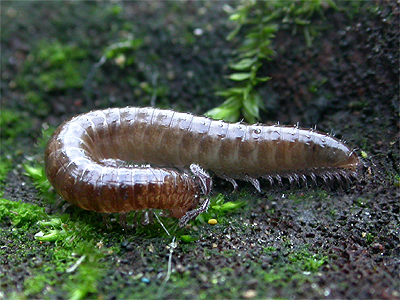 |
|
| Insects |
| Homepage |